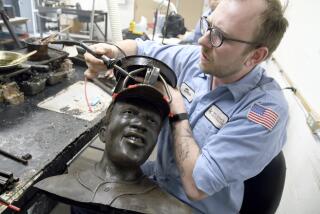Treasure Hunters Still Ascend Mountains in Search of Artifacts
- Share via
RANDOLPH, N.H. — Almon Farrar, 88, has heard stories all his life about missing treasure in the White Mountains where he grew up.
His uncle, a game warden who crisscrossed the mountains through much of the first half of the 20th century, always kept an eye out for it while he pursued poachers.
“Everybody’s hunted for it,” Farrar said as he took a break from cutting firewood in the yard of his home in the Cascade and Castle ravines. “I tell you it’s rough up there.”
Up there, not far from Farrar’s house, is some of the most rugged terrain in the Northeast. That’s where eight rangers from an elite force of frontiersmen attached to the British army during the French and Indian War perished, supposedly while carrying a silver statue of the Virgin Mary and Christ child.
The rangers are believed to have taken the 10-pound statue, a ruby ring, a gold calf and other priceless artifacts during a 1759 raid on a Jesuit mission at an Indian settlement in Quebec. Much of the treasure is still lost today somewhere on the north side of 6,288-foot Mt. Washington.
Throughout the 19th century, treasure hunters prowled the mountains of New Hampshire, and some still come.
Last summer two men sought information about the rangers’ path from the Lancaster Historical Society. The pair planned to use a metal detector to hunt the statue.
Father Jacques Monet, director of the Jesuit archives in Toronto, can find no record of the missing artifacts but says it is plausible that they would have been housed at the mission.
“They had these benefactors in Europe who would send these things to the missions,” he said.
Forty years of mission records were destroyed in the raid on St. Francis by rangers under the command of Maj. Robert Rogers, who in 1756 formed a 600-man contingent that came to be known as Rogers’ Rangers. About 140 Colonial soldiers and a handful of British regulars went up Lake Champlain and crossed the broad plains of the St. Lawrence Valley before attacking the Abenaki village of St. Francis near present-day Pierreville, Quebec.
The raid at dawn on Oct. 4, 1759, was revenge for a series of attacks by the Indians on the Colonies.
Rogers later claimed to have killed about 200 Indians, but French and Abenaki records put the number much lower -- perhaps 30, including 20 women and children.
During the raid, Rogers’ men stumbled across the Jesuit mission and helped themselves to gold and silver, including the replica of the seated Virgin Mary with the baby Jesus on her lap.
Military historian Gary Zaboly, who is researching a book for the 250th anniversary of the war, found a November 1759 article in the New York Gazette that included a letter with a contemporaneous account of the raid:
“The people did bring away considerable plunder, but they drop’d them, or the greater Part before they arrived at Connecticut River. Tis also said, that one man brought off 1,700 guineas; and another a silver image of 10 lb. wt,” New Jersey Capt. Amos Ogden wrote in the letter from Ft. No. 4 at Charlestown, N.H., after the raid.
A description included in a 2002 history of Rogers’ Rangers by another military historian, Burt Garfield Loescher, went further:
“Her head was surmounted by a high crown containing many points, covered by leafy rosettes. The infant Jesus resting on her knees wore no crown. In his little left hand he held a globe of the world while his right hand was uplifted in the customary sign of benediction.”
Rogers’ plan was to return to Lake Champlain and sail back south in boats he had left in Missisquoi Bay. But the French discovered the boats and destroyed them. His alternate route went through what is now northeastern Vermont and northern New Hampshire.
The French and their Indian allies pursued the rangers, who were hampered by the weight of their plunder. As winter approached, they suffered from the cold and began to go hungry.
The statue was in a knapsack carried by Sgt. Benjamin Bradley, of Concord. When Bradley and eight other soldiers reached the Connecticut River, an Indian guide promised to show them a shortcut to a pass, up the Israel River and home.
Instead, they were led into the Castle and Cascade ravines.
One by one the soldiers perished. The only survivor had no information about the statue.
In 1816, a farmer in either Newport, Vt., or Quebec -- reports vary -- plowed up a pair of golden candlesticks valued at the time at $1,000.
In 1827, an incense vessel was found on the banks of the St. Francis River in Quebec. Rusted muskets, tomahawks, decaying uniforms and human remains, thought to be from the rangers, have been found throughout the region.
Loescher’s book says the items plundered from St. Francis also included a ruby ring “as big as your eye,” a stash of coins and a golden calf. The coins were said to have been buried near the spot where the Cow Brook flows into the Connecticut in Littleton, N.H.
The river has changed course since then, however. Now the spot is beneath the Moore Reservoir.
It’s unclear what condition the statue would be in today. Anthony Blumka, a New York antique dealer who specializes in medieval, Renaissance and baroque art, said silver would survive the intervening 245 years better than some materials.
“It might stand a chance,” he said.
More to Read
Sign up for Essential California
The most important California stories and recommendations in your inbox every morning.
You may occasionally receive promotional content from the Los Angeles Times.











